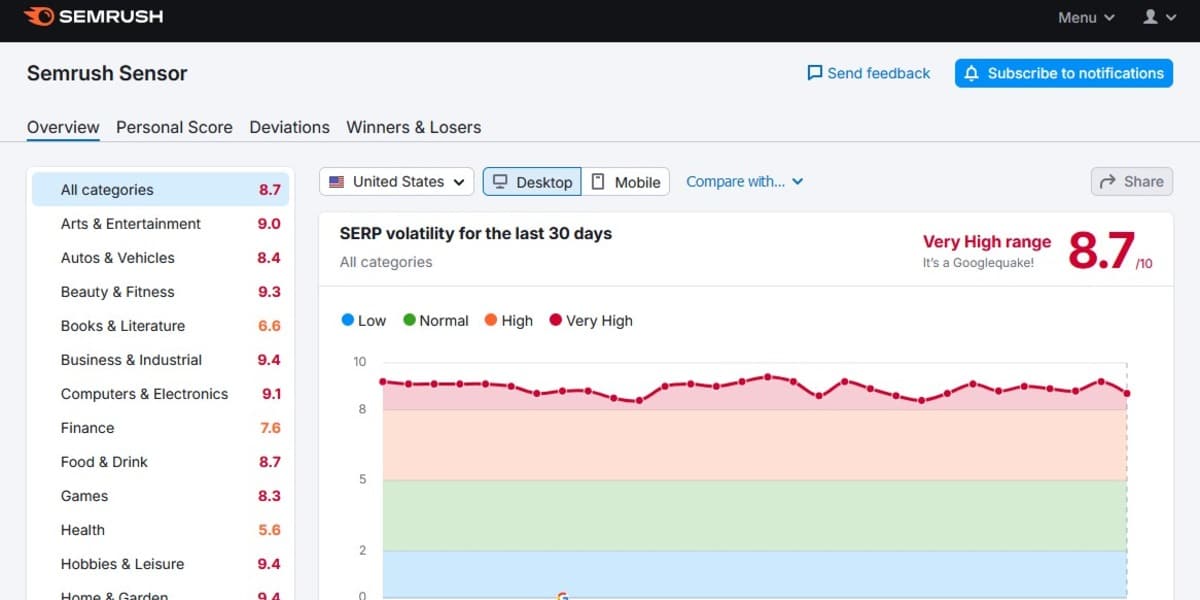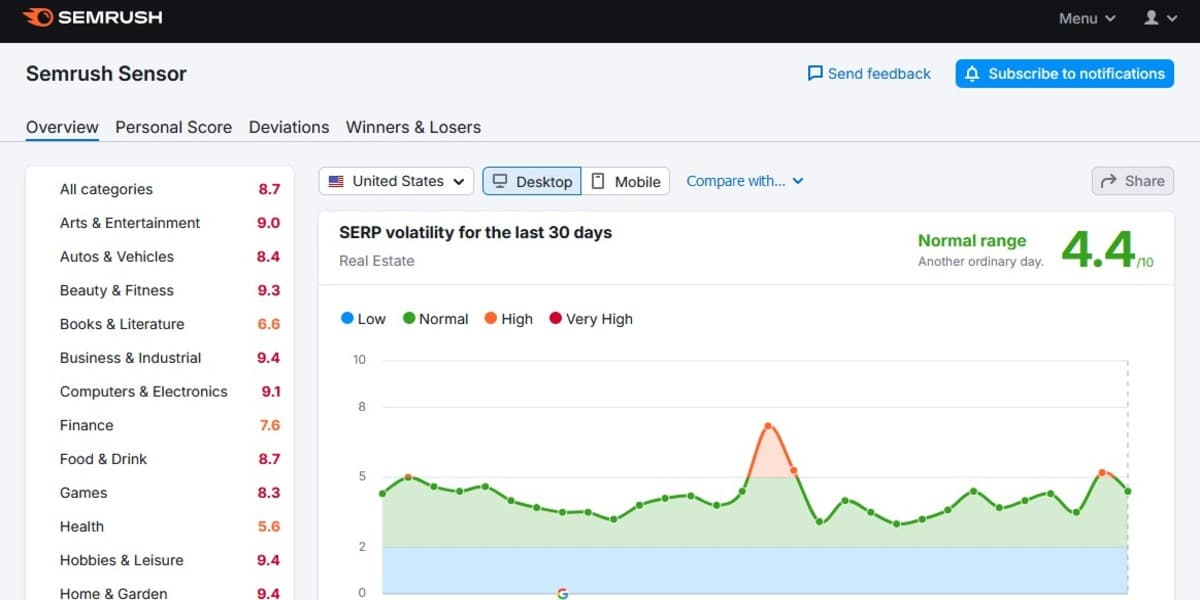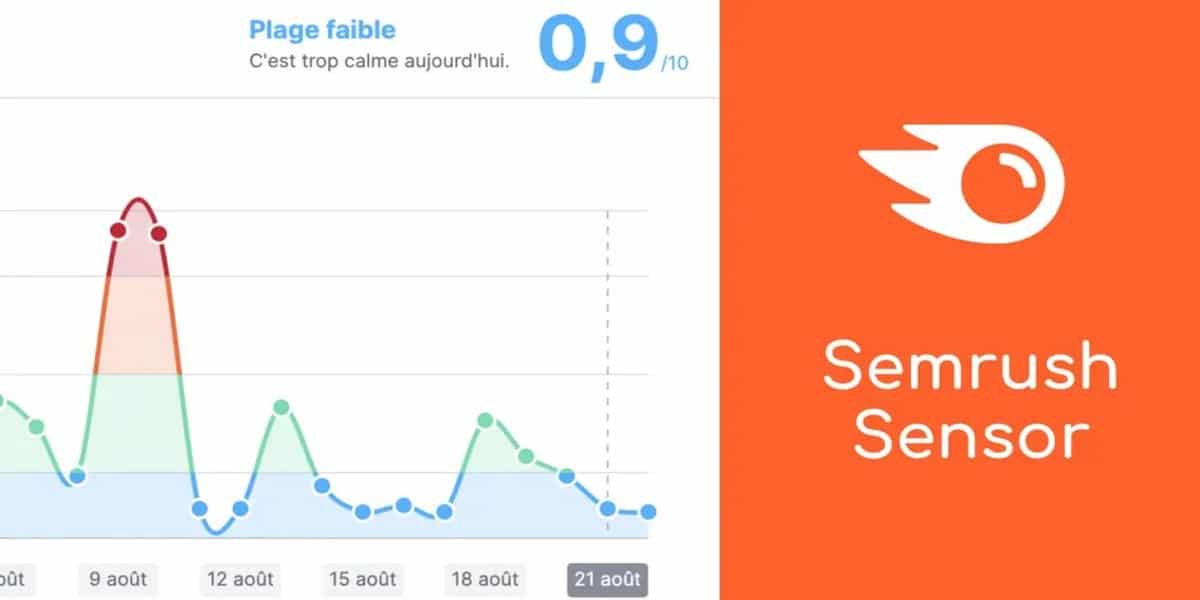Have you been struggling to find out why your website’s rankings are constantly changing? It may be time to give SEMrush Sensor a try. SEMrush Sensor is a powerful tool that allows you to track Google algorithm updates. In this guide, we will explain what SEMrush Sensor is, and how it can help you manage SERP Volatility and the changes in search rankings.
How SEMrush Sensor Works
The purpose of SEMrush Sensor is to give website owners and SEO specialists an easy way to track how Google algorithm updates affect their search engine rankings. This tool reviews data from millions of searches, analyzing it to identify trends as well as important changes in the SERPs. In other words, SEMrush Sensor is an effective tracker of search engine data.
As we have already mentioned, SEMrush Sensor has access to a large database of search engine data. The tool is able to detect when search results become volatile. This usually means that an update is going to be released very soon. Since SEMrush Sensor regularly monitors such changes, it sends alerts to its users. Thus, they have enough time to prepare for ranking shifts.
Key Features
There are many features to highlight when it comes to SEMrush Sensor:
- It performs ongoing analysis of search engine data.
- Its algorithms identify when the search results become volatile, suggesting a possible update to come.
- You get detailed information on how your rankings have changed over time.
- The tool enables you to monitor the performance of your competitors and adjust your strategy if needed.
- With its large database, SEMrush Sensor keeps track of all past algorithm updates and their results. This information adds context to when planning your future actions.
- You will receive alerts on major changes in your site’s performance, which are customizable.
By using all these features, you can deepen your understanding of Google algorithm updates and be sure your online presence stays ahead of the game.
How to Read the SEMrush Sensor Data
Since Google algorithm updates influence your site’s performance to a significant extent, it is vital to understand SEMrush Sensor Data. Being easy to use, SEMrush Sensor provides you with a wide range of information concerning your ranking and the changes in it. By analyzing the data related to your site, it is possible to predict how Google algorithm updates can affect your website’s performance.
Primarily, it is important to monitor the Volatility Score, a metric that reflects the stability of search engine results. In fact, when the rates are high, it indicates the possibility of an update in algorithms. Thus, if the scores remain high for a longer period, it is advisable to track the site’s stability and be prepared for changes affecting your site.
In addition, it is crucial to pay attention to the Ranking Fluctuations since it demonstrates the changes in your site’s position in SERPs. This information will help you transform and improve specific pages, keywords, or categories.
Finally, it is impossible not to consider Competitor tracking that provides you with the ranking change of others. This information helps you keep an eye on your rivals’ rankings and adjust your strategies and methods more effectively.
Benefits of Using SEMrush Sensor

There are several benefits to using SEMrush Sensor for monitoring Google algorithm updates:
- SEMrush Sensor allows real-time tracking of the updates, enabling one to adjust on-going SEO tactics in good time.
- It will help you to stay ahead and informed about what is coming, giving your site the edge over the competition.
- It assists in responding to the effects of these updates, leading to better rankings, reducing the bounce rate, and offering better user-engagement.
- The tool provides insights on where to place the SEO efforts in order to get the best results.
- Also, it will save a business the time and resources to monitor these updates, allowing one to concentrate on other productive marketing activities.
- Finally, it will help in the attraction of visitors, generation of leads, and growing of revenue.
In sum, SEMrush Sensor is a valuable tool for anyone looking to understand the complexities of search algorithms and optimize their site under that constraint.

Tips on Using SEMrush Sensor
In order to have a better experience when using SEMrush Sensor for monitoring Google algorithm updates, one should put the following tips into consideration:
- Custom Alerts: You should configure their sensor settings to get the most relevant updates, including notifications of significant SERP changes for your website or that of your competitor.
- Review SEMrush Sensor Data: You should always view the Sensor data in order to note any changes or patterns that might signify an update.
- Monitor Ranking Fluctuations: You should always check the SEMrush Ranking Fluctuations to know which of the pages or keywords are affected by updates.
- Check Changes for Competitors: You should monitor your competitive rivals to ascertain whether their ranking changes hold any consequences for your site.
- Check History: You should check the SEMrush Sensor data of the past updates to better prepare for future ones.
- Integrate the SEMrush data with other SEO tools: SEMrush Sensor alone will not guarantee good results. You should supplement it with other data, such as information from GSC and Google Analytics.
Finally, act fast when the Volatility Score shows significant search changes. adapting your SEO strategy as needed.
Conclusion
SEMrush Sensor is a needed tool to all those concerned with SEO. It provides real-time information about Google algorithm updates while they occur. So, whether you are a small business owner, a content creator or a professional on a path to organic traffic success, algorithm updates are something that you want to respond to. With SEMrush Sensor, one will have the power to achieve superior site performance that is going to be attracting more organic traffic and, by extension, attract more business in the daily routine.
Looking for an international SEO agency to improve your ranking? We are here to assist. Contact us now to learn how we can help you or leave us a message on Facebook or LinkedIn.
Images are from Pixabay.com



Ahrefs Backlinks Checker: How to Use Guide
PPC VS SEO: Which One Should You Go for?